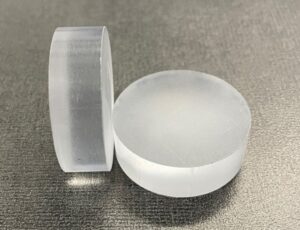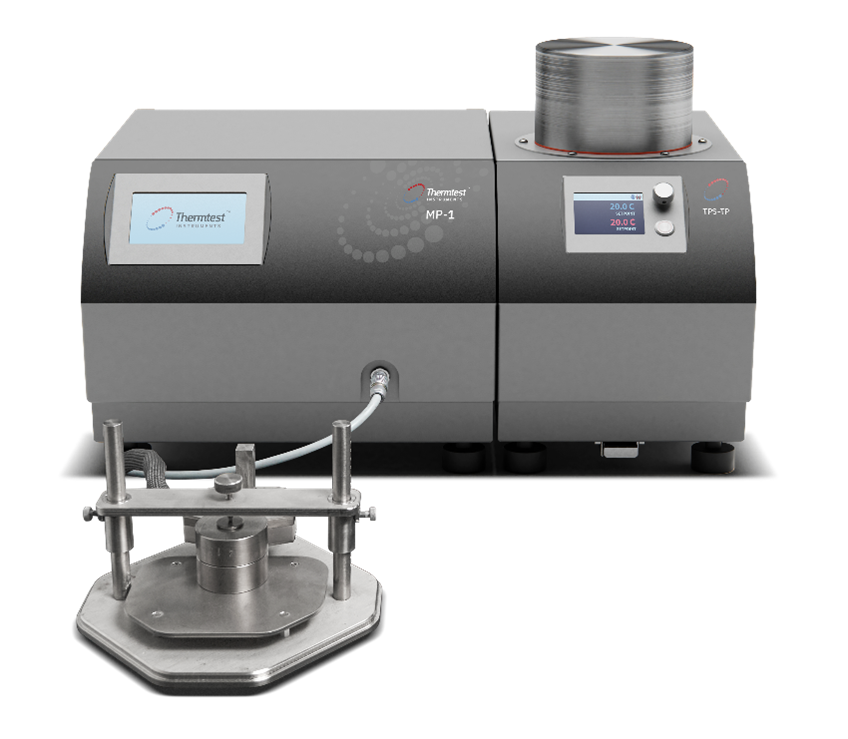Polycarbonates are a class of thermoplastic polymers known for their tough but easily moldable properties. This versatility makes them very popular for applications in a wide range of industries. Polycarbonates are naturally transparent which allows them to take on a variety of applications where transparency is a must that other materials with similar strength and flexibility cannot. Polycarbonate thermoplastics also have excellent thermal and electrical resistance, which makes them the perfect choice for insulator applications. But with these extreme temperatures how are the thermophysical properties of polycarbonates affected?
This application will investigate the thermophysical properties of polycarbonates at high temperatures by measuring the change in thermal conductivity (W/m·K), thermal diffusivity (mm2/s), and volumetric specific heat (MJ/m3K) of two polycarbonate samples with increasing temperature.
Samples of polycarbonate thermoplastic of were measured for thermal conductivity (W/m·K), thermal diffusivity (mm2/s), and volumetric specific heat (MJ/m3K) using the MP-1 Transient Plane Source (TPS) Method: Standard Module. The MP-1 with TPS Standard Module is used to measure the average or bulk thermal conductivity and thermal diffusivity of isotropic materials. The Temperature Platform (TP) was used as an add on to the MP- 1 to measure polycarbonate with temperature. The Temperature Platform is a compact heating-cooling apparatus for the measurement of thermophysical properties by both the TPS and THW methods.
The term polycarbonate refers to a group of thermoplastic polymers that contain carbonate groups in their chemical structures. They are tough, naturally transparent, synthetic resins and although commercially available in a variety of colors, the raw material allows for light to pass through in nearly the same capacity as glass. Polycarbonates produce many different types of materials and are particularly useful when impact resistance and transparency are a requirement.

Figure 1. Polycarbonate Samples
The MP-1 is designed to test the absolute thermal conductivity, thermal diffusivity and specific heat of solids, liquids, pastes and powders with the powerful combination of the transient plane source (TPS, ISO 22007-2) and transient hot-wire (THW, ASTM D7896-19) methods.
The Thermtest Transient Plane Temperature Platform (TPS-TP) is an add-on for the MP-1 system that allows the user to make measurements from 0 to 300oC with expanded capabilities of -50 to 300oC. Samples to be tested in the TPS-TP must be below the maximum sample size of 40mm in diameter and 20mm in height.

Figure 2. Measurement Platform-1 (MP-1) with Transient Plane Source Temperature Platform (TPS-TP).
Polycarbonates are ideal materials for many applications and well known for their versatile characteristics. Key properties include high impact strength, transmittance, heat resistance, and chemical resistance. Polycarbonates are often used in applications where impact-resistance and transparency are the principal requirements such as automotive components, protective gear, eyewear, medical devices, etc. Although they are extremely durable thermoplastics, they are also highly pliable. Unlike other similar polymers, they have the ability to be formed into different shapes at relatively low temperatures. Their unique set of qualities make it even more ideal than glass and PMMA in many applications.
The polycarbonate samples were measured in the symmetric configuration using the standard 6.4mm radius double spiral TPS sensor (3317-1). Optimal measurement parameters of 80s and 20mW were determined using the proprietary iTransient application.
Table 1. Thermophysical measurements of polycarbonate thermoplastic from 10 to 100ᵒC.
| Temperature (ᵒC) | Thermal Conductivity (W/m·K) | Thermal Diffusivity (mm2/s) | Volumetric Specific Heat (MJ/m3K) |
| 10 | 0.23 | 0.18 | 1.35 |
| 20 | 0.23 | 0.18 | 1.37 |
| 30 | 0.24 | 0.18 | 1.48 |
| 40 | 0.23 | 0.18 | 1.45 |
| 50 | 0.23 | 0.16 | 1.48 |
| 60 | 0.23 | 0.16 | 1.52 |
| 70 | 0.23 | 0.15 | 1.55 |
| 80 | 0.24 | 0.15 | 1.62 |
| 90 | 0.23 | 0.15 | 1.65 |
| 100 | 0.23 | 0.15 | 1.64 |
Polycarbonate 6.4mm radius (3317-1), 80 sec. 0.02 W, 23°C, n=5.
It is clear why polycarbonate is so commonly used in many different industries today. Its unique characteristics of flexibility, durability, transparency, and thermal resistance put it far in advance of other polymers. As displayed in this application, its thermophysical properties are able to withstand high temperatures and remain stable.